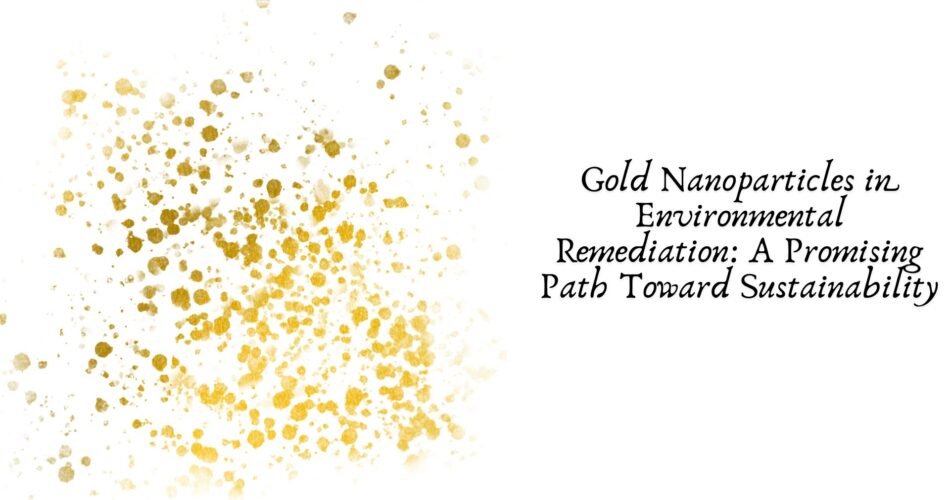The rise of nanotechnology has unlocked innovative solutions for some of the world’s most pressing challenges, including environmental pollution. Among the many nanomaterials studied, gold nanoparticles (AuNPs) have drawn significant attention for their unique physical, chemical, and catalytic properties. Traditionally prized for their applications in medicine, electronics, and sensing, gold nanoparticles are now emerging as promising agents in environmental remediation—a field dedicated to reducing, removing, or neutralizing pollutants from air, water, and soil.
This article explores how gold nanoparticles contribute to environmental cleanup, their mechanisms of action, advantages, challenges, and future directions.
Why Gold Nanoparticles?
Gold, in its bulk form, is considered inert and resistant to corrosion. However, when reduced to the nanoscale, gold exhibits remarkable properties such as:
- High surface area-to-volume ratio – providing abundant reactive sites.
- Plasmonic properties – enabling light-driven reactions.
- Chemical stability – ensuring long-term performance under environmental conditions.
- Biocompatibility – making them safer than many other metallic nanoparticles.
These characteristics make gold nanoparticles ideal candidates for use in environmental applications, particularly in catalysis and sensing.
Applications in Environmental Remediation
Water Purification
Water contamination by organic pollutants, heavy metals, and dyes poses severe environmental and health risks. Gold nanoparticles have been used in various water treatment strategies, including:
- Catalytic degradation of organic pollutants: AuNPs act as catalysts in reducing toxic dyes like methylene blue and nitroaromatics, converting them into less harmful compounds.
- Heavy metal detection and removal: Functionalized gold nanoparticles bind selectively to heavy metal ions such as mercury (Hg²⁺) and lead (Pb²⁺), allowing efficient removal or detection at trace levels.
- Photocatalysis: When combined with semiconductor materials (e.g., TiO₂), AuNPs enhance photocatalytic performance under visible light, accelerating the breakdown of pollutants.
Air Pollution Control
Airborne pollutants like volatile organic compounds (VOCs), carbon monoxide, and nitrogen oxides contribute to poor air quality. Gold nanoparticles, particularly in supported form (e.g., dispersed on metal oxides), have been shown to:
- Catalyze CO oxidation at relatively low temperatures.
- Aid VOC breakdown into less harmful byproducts.
- Promote photocatalytic reactions for air purification under sunlight or artificial light.
These properties make AuNP-based catalysts attractive for air filtration systems and industrial emissions control.
Soil Remediation
Soil contamination by hydrocarbons, pesticides, and heavy metals is a global challenge. While research is still developing, AuNPs show potential in:
- Detoxifying hydrocarbons via catalytic oxidation.
- Binding toxic metals to prevent leaching into groundwater.
- Facilitating microbial activity by creating favorable conditions for bioremediation when used in hybrid systems.
Sensing and Monitoring Pollutants
Beyond active remediation, gold nanoparticles are valuable tools for environmental monitoring, which is a critical first step in pollution control. Their optical properties allow for:
- Colorimetric sensors: AuNPs change color upon interaction with specific pollutants, offering simple, visual detection methods.
- Surface-enhanced Raman spectroscopy (SERS): Gold nanoparticle substrates amplify signals from trace pollutants, enabling ultra-sensitive detection.
- Electrochemical sensors: AuNPs improve the sensitivity of electrodes for detecting environmental toxins.
Advantages of Gold Nanoparticles in Remediation
- High catalytic efficiency at low concentrations.
- Sustainability – can be reused multiple times without significant loss of activity.
- Selectivity – functionalization allows targeting of specific pollutants.
- Compatibility with hybrid systems (e.g., combining with polymers, semiconductors, or carbon nanomaterials).
Challenges and Considerations
While gold nanoparticles offer many advantages, their use in large-scale environmental remediation faces challenges:
- High production costs compared to other nanoparticles like iron or silver.
- Potential toxicity to aquatic and terrestrial organisms at certain concentrations.
- Aggregation issues, which may reduce catalytic performance.
- Recovery and recycling after use, to prevent secondary pollution.
Researchers are addressing these challenges by developing cost-effective synthesis methods (e.g., green synthesis using plant extracts), improving surface modifications, and designing recyclable AuNP-based systems.
Future Outlook
The application of gold nanoparticles in environmental remediation is still evolving, but their potential is undeniable. Future advancements may include:
- Green synthesis techniques to lower costs and enhance eco-friendliness.
- Hybrid nanocomposites combining AuNPs with graphene, zeolites, or biodegradable polymers for improved efficiency.
- Scalable technologies for industrial wastewater treatment, air purification, and soil detoxification.
- Regulatory frameworks ensuring safe deployment and lifecycle management of nanomaterials.
Conclusion
Gold nanoparticles represent a transformative tool in the fight against environmental pollution. With their catalytic prowess, stability, and multifunctionality, they hold the promise of cleaner water, purer air, and healthier soil. Although challenges remain—particularly regarding cost, scalability, and ecological safety—continued research and innovation are likely to make gold nanoparticle-based remediation technologies an integral part of sustainable environmental solutions.
